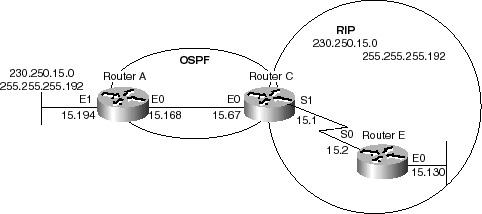Advanced OSPF Design Concepts
To fix the situation in this example, you could stop RIP from being sent on Router A’s Ethernet0 via a passive interface. This might not be suitable in case some routers on the Ethernet are RIP only routers. In this case, you could allow Router C to send RIP on the Ethernet; this way Router A will not send it back on the wire because of split horizon. (This might not work on NBMA media if split horizon is off.) Split horizon does not allow updates to be sent back on the same interface from which they were learned (via the same protocol). Another good method is to apply distribute-lists on Router A to deny subnets learned via OSPF from being put back into RIP on the Ethernet. The latter is the one you will be using: Router A# interface Ethernet0 ip address 203.250.15.68 255.255.255.192 router ospf 10 redistribute rip metric 10 subnets network 203.250.15.0 0.0.0.255 area 0 router rip redistribute ospf 10 metric 1 network 203.250.15.0 distribute-list 1 out ospf 10 The correct routing table that is seen in Router C would be as follows: Router C# show ip route Codes: C - connected, S - static, I - IGRP, R - RIP, M - mobile, B - BGP D - EIGRP, EX - EIGRP external, O - OSPF, IA - OSPF inter area E1 - OSPF external type 1, E2 - OSPF external type 2, E - EGP i - IS-IS, L1 - IS-IS level-1, L2 - IS-IS level-2, * - candidate default Gateway of last resort is not set 203.250.15.0 255.255.255.192 is subnetted, 4 subnets C 203.250.15.0 is directly connected, Serial1 C 203.250.15.64 is directly connected, Ethernet0 R 203.250.15.128 [120/1] via 203.250.15.2, 00:00:19, Serial1 O 203.250.15.192 [110/20] via 203.250.15.68, 00:21:41, Ethernet0 Injecting Default Routes into OSPFThe capability to generate and redistribute default routes is of extreme importance within any large network. An ASBR can be forced to generate a default route into an OSPF Network (domain). As discussed earlier, a router becomes an ASBR whenever routes are redistributed into an OSPF network (domain). However, an ASBR does not, by default, generate a default route into an OSPF network (domain).
There are several ways to generate a default route within an OSPF network. The first is to advertise 0.0.0.0 inside the domain, but only if the ASBR itself already has a default route. The second is to advertise 0.0.0.0 regardless of whether the ASBR has a default route. This can be set by adding the keyword always. Be very careful when using the always keyword. If your router advertises a default (0.0.0.0) inside the domain and does not have a default itself or a path to reach the destinations, routing will be broken. The third is to be in an OSPF stub area that needs a default exit, hence the default route is used. To have OSPF generate a default route, use the following configuration command: default-information originate [always] [metric metric-value] [metric-type type-value] [route-map map-name] The metric and metric-type are the cost and route type (E1 or E2) assigned to the default route. The route-map specifies the set of conditions that need to be satisfied in order for the default to be generated. Figure 6-9 shows a sample network and an example demonstrates how a default route will be determined.
Referring to Figure 6-9 and assuming that Router E is injecting a default route of 0.0.0.0 into the RIP network and Router C will have a gateway of last resort of 203.250.15.2, the following is true of Routers A, C, and E:
The following example shows that Router C knows about the default route, but it will not tell anyone else until told to do so with the default-information originate command. Router C# show ip route Codes: C - connected, S - static, I - IGRP, R - RIP, M - mobile, B - BGP D - EIGRP, EX - EIGRP external, O - OSPF, IA - OSPF inter area E1 - OSPF external type 1, E2 - OSPF external type 2, E - EGP i - IS-IS, L1 - IS-IS level-1, L2 - IS-IS level-2, * - candidate default Gateway of last resort is 203.250.15.2 to network 0.0.0.0 203.250.15.0 255.255.255.192 is subnetted, 4 subnets C 203.250.15.0 is directly connected, Serial1 C 203.250.15.64 is directly connected, Ethernet0 R 203.250.15.128 [120/1] via 203.250.15.2, 00:00:17, Serial1 O 203.250.15.192 [110/20] via 203.250.15.68, 2d23, Ethernet0 R* 0.0.0.0 0.0.0.0 [120/1] via 203.250.15.2, 00:00:17, Serial1 [120/1] via 203.250.15.68, 00:00:32, Ethernet0 interface Ethernet0 ip address 203.250.15.67 255.255.255.192 interface Serial1 ip address 203.250.15.1 255.255.255.192 router ospf 10 redistribute rip metric 10 subnets network 203.250.15.0 0.0.0.255 area 0 default-information originate metric 10 router rip redistribute ospf 10 metric 2 passive-interface Ethernet0 network 203.250.15.0 Now that Router C has been configured to tell Router A about the default route, you can check Router A’s routing table. You will quickly see that the default route is known by the router: Router A# show ip route Codes: C - connected, S - static, I - IGRP, R - RIP, M - mobile, B - BGP D - EIGRP, EX - EIGRP external, O - OSPF, IA - OSPF inter area E1 - OSPF external type 1, E2 - OSPF external type 2, E - EGP i - IS-IS, L1 - IS-IS level-1, L2 - IS-IS level-2, * - candidate default Gateway of last resort is 203.250.15.67 to network 0.0.0.0 203.250.15.0 255.255.255.192 is subnetted, 4 subnets O 203.250.15.0 [110/74] via 203.250.15.67, 2d23, Ethernet0 C 203.250.15.64 is directly connected, Ethernet0 O E2 203.250.15.128 [110/10] via 203.250.15.67, 2d23, Ethernet0 C 203.250.15.192 is directly connected, Ethernet1 O*E2 0.0.0.0 0.0.0.0 [110/10] via 203.250.15.67, 00:00:17, Ethernet0
|
EAN: 2147483647
Pages: 200
